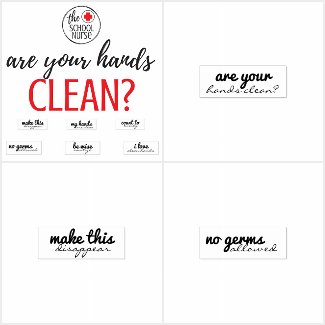Handwashing for Students:
Why, When, and How to Keep Germs Away
But do your students really know the why, when, and how of handwashing? Let’s explore this important habit, and I’ll share a fun classroom hand hygiene lesson using a Glow Germ kit or ink stamps to help students practice proper handwashing steps.
Why is Handwashing Important for Students?
Handwashing isn’t just about keeping hands clean; it’s one of the best ways to prevent the spread of germs. Germs are everywhere—on desks, doorknobs, and shared equipment. If students don’t wash their hands properly, these germs can easily transfer to their bodies, causing illnesses like colds, the flu, and stomach bugs.
Teaching students hand hygiene in schools is a crucial step in keeping everyone healthy and preventing germs from spreading to others.
When Should Students Wash Their Hands?
To protect against germs, students should wash their hands regularly. Here are the most important times they should wash their hands:
- When hands are visibly dirty
- Before preparing or eating food
- After using the restroom
- Before and after helping someone else
- After playing with an animal
- After PE class or sports games
- When they get home from school
- After coughing or sneezing
- Whenever their hands feel dirty
Regular handwashing helps prevent germs from spreading, which keeps classrooms and homes healthier.
How to Wash Hands Properly
Now, let’s dive into the proper handwashing steps. Many students don’t realize there’s a right way to wash their hands. Here's a simple breakdown:
- Stand a few inches away from the sink and turn on warm water.
- Wet your hands with warm water, keeping hands lower than your elbows.
- Apply soap and rub hands together for at least 20 seconds, making sure to scrub:
- Under the nails
- Between fingers
- Around the wrists
- Rinse hands with warm water, fingertips pointed down.
- Dry hands with a paper towel, starting from the fingertips and moving up to the wrists.
- Use the paper towel to turn off the faucet, then throw it away.
Following these steps ensures students remove all the germs that could make them sick, especially after activities like PE or after they’ve touched shared surfaces.
Want to make handwashing more engaging for students? Try a fun handwashing lesson that demonstrates how well they wash their hands. This activity can be done with either a Glow Germ kit or ink stamps.
- Apply Glow Germ lotion or powder to students’ hands.
- Have them wash their hands as usual.
- Use a black light to reveal the areas they missed, like under their nails or between their fingers.
- This visual lesson is a great way to show how germs can hide even when they think they’ve washed well!
- Stamp students' hands with washable ink before they wash them.
- Have them wash their hands, following the proper steps.
- Afterward, check how well they removed the ink—this represents how well they removed germs.
- If they missed spots, encourage them to wash again, focusing on those areas.
This classroom hand hygiene activity gives students hands-on experience with proper technique, making the lesson both fun and memorable!
3. Pepper / Water / Soap Experiment- This one is always a classroom favorite!
Make Handwashing a Habit
Incorporating hand hygiene in schools is a simple but crucial way to keep students healthy. By teaching students how to wash hands properly and making it fun with activities like Glow Germ or ink stamps, you’ll help them build lifelong habits that prevent the spread of germs.
Remember, as a school nurse, you’re in a unique position to influence your students' health in a positive way. Let’s work together to keep our schools germ-free and our students healthy with these important handwashing lessons!








No comments:
Post a Comment